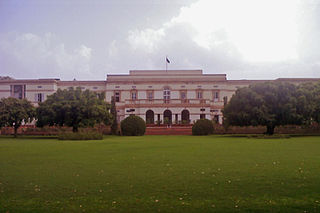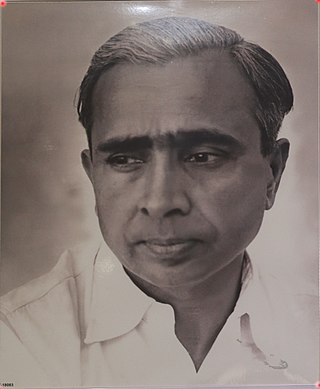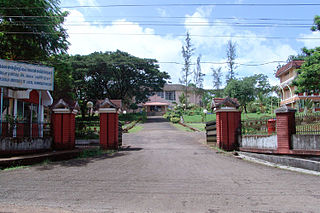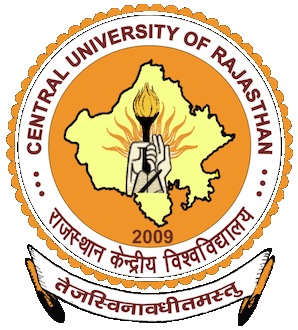This article needs additional citations for verification .(October 2018) |
The University of Rajasthan Library is an academic library at the heart of the University of Rajasthan.
This article needs additional citations for verification .(October 2018) |
The University of Rajasthan Library is an academic library at the heart of the University of Rajasthan.
The University of Rajasthan was established by an act of legislature on 8 January 1947. The library was created later on, after the availability of a small annex in the same compound in 1949. A budget provision of 20,000 Rs. was made for the library and about 1,500 books were immediately acquired. The first book, Preface to Library Science by Dr. S. R. Ranganathan, was added on 11 May 1950.
The library which was initiated in the corner of the office of the First Vice-Chancellor Dr. G. S. Mahajani in Kesargarh (a fort-like structure on Jawaharlal Nehru Marg, which now houses the offices of the popular Hindi newspaper Rajasthan Patrika ). The library moved to the completed portion of the new building in October 1958. Jawaharlal Nehru formally inaugurated the new building in October 1959.
Rajasthan University is close to the now-famous Bidla Mandir on the Jawaharlal Nehru Marg. The central Library is near the entrance gate of the university on its left side.
The building of the library has a spread of the traditional red stone of Jaipur. The surrounding of the building has greenery all around. The massive building is an area of 10,000 sq. mt. Area of the reading rooms is 3000 sq. mt. and carpet area for stack room is 4000 sq. mt.
A new building has been added to the existing library. This is named as Dr Babasaheb Bhimrao Ambedkar Library Building. This will house modern library facilities, including digital library services. The building has been inaugurated on 16 November 2022 by Sh Ashok Gehlot, the Chief Minister of Rajasthan government.
The post of University Librarian is vacant. Professor S. L. Jain [1] is honorary director of this library.[ clarification needed ]
The library holds a collection of more than 4 lakh documents, which includes books, bound journals, theses, reports, microfilms, etc. The library acquires current journals. In addition the library provides access to e-journals available through UGC Infonet e-journals consortia.
The library has a rich collection of documents of historical importance to the State of Rajasthan. A part of the collection of the British resident then stationed at Mount Abu has been inherited by the Rajasthan University Library, which is popularly known as Abu Collection. This includes government reports, gazetteers and other publications dating back to early 19th century.
The library has the collection of microfilms and microfiches. This collection of the library includes a variety of reports, for example, census of India publications of the earlier period beginning from 1872, a large number of gazetteers of India down to district level published during the British period. The memoirs and annual reports of Archaeological Survey of India, legislative proceedings/debates for the period 1854 to 1957 for the Central Legislative Body, proceedings of many other legislative bodies in the country, a large number of periodicals, many newspapers (e.g., Tribune from 1881 to 1995), newspapers from a number of South Asian countries etc. The library has microfilm readers to facilitate the use of these documents.
The University Library has developed a number of special collections namely Hindi Collection, Jain Collection, Rajasthan Collection, and Fine Arts Collection.
The library has a small collection of CD-ROM databases.
The collection of some science books and journals is located in the concerned departments.
Besides, some reading material is available in departmental libraries. The departmental libraries in the university are in the departments: Academic Staff College, Faculty of Fine Arts, Indira Gandhi Centre for Human Ecology Environment and Population Studies, History, Law, Library and Information Science, Philosophy and Podar Institute of Management.
A variety of library services, in addition to user consultation and lending facilities, are offered, via general guidance and orientation, reference service, reprography service, Interlibrary loan service, database search service, online search options, information display and notification, Internet and e-mail facility, CD-ROM database search service, e-journal accessibility, etc.

Rajasthan is a state in northern India. It covers 342,239 square kilometres (132,139 sq mi) or 10.4 per cent of India's total geographical area. It is the largest Indian state by area and the seventh largest by population. It is on India's northwestern side, where it comprises most of the wide and inhospitable Thar Desert and shares a border with the Pakistani provinces of Punjab to the northwest and Sindh to the west, along the Sutlej-Indus River valley. It is bordered by five other Indian states: Punjab to the north; Haryana and Uttar Pradesh to the northeast; Madhya Pradesh to the southeast; and Gujarat to the southwest. Its geographical location is 23.3 to 30.12 North latitude and 69.30 to 78.17 East longitude, with the Tropic of Cancer passing through its southernmost tip.

Jaipur, formerly Jeypore, is the capital and largest city of the Indian state of Rajasthan. As of 2022, the city had a population of 4.5 million, making it the tenth most populous city in the country. Jaipur is also known as the Pink City, due to the dominant colour scheme of its buildings. It is also known as the Paris of India, and C. V. Raman called it the Island of Glory. It is located 268 km from the national capital New Delhi. Jaipur was founded in 1727 by the Kachhwaha Rajput ruler Jai Singh II, the ruler of Amer, after whom the city is named. It was one of the earliest planned cities of modern India, designed by Vidyadhar Bhattacharya. During the British Colonial period, the city served as the capital of Jaipur State. After independence in 1947, Jaipur was made the capital of the newly formed state of Rajasthan.

The Teen Murti Bhavan was built by British as the residence New Delhi of the Prime Minister of India, Jawaharlal Nehru. He stayed there for 16 years until his death on 27 May 1964. It was designed by Robert Tor Russell, the British architect of Connaught Place and of the Eastern and Western Courts on Janpath during the British Raj. Teen Murti Bhavan was built in 1930 as part of the new imperial capital of India, New Delhi as the residence of the Commander-in-Chief of the British Indian Army.

University of Rajasthan is a public and state university in Jaipur, Rajasthan, India and is one of the oldest universities in the state. It was set up on 8 January 1947 as the University of Rajputana and was given its current name in 1956.

Laxmi Mall Singhvi was an Indian jurist, parliamentarian, scholar, writer and diplomat. He was, after V. K. Krishna Menon, the second-longest-serving High Commissioner for India in the United Kingdom (1991–97). He was conferred with a Padma Bhushan in 1998.

Takhatgarh is a town in Sumerpur tehsil of Pali District of Rajasthan state in India. The town is one of the nine municipalities in the district, located near the district border. It is only about 160 years old.

Kesava Shankar Pillai, better known as Shankar, was an Indian cartoonist. He is considered the father of political cartooning in India. He founded Shankar's Weekly, India's Punch in 1948. Shankar's Weekly also produced cartoonists like Abu Abraham, Ranga and Kutty, he closed down the magazine during the Emergency of 25 June 1975. From then on he turned to making children laugh and enjoy life.
University Maharaja's College is a college in Jaipur, the capital of the Rajasthan state in India. Established in 1844 by Sawai Ram Singh II, it has been affiliated with University of Rajasthan since 1947. Maharaja college offers course on campus in Bachelor of Science (BSc) and Bachelor of Computer Application (B.C.A) at Undergraduate (U.G.) level. The college was granted the status of "college with potential excellence" by UGC in 2011.

Jawaharlal Nehru Medical College, Ajmer is a government medical college located in Ajmer (Rajasthan), India. Established in 1965, it is one of six government-run medical colleges in the western state of Rajasthan, and the fourth to be established in the state. It is affiliated with RUHS, and provides education leading to the Bachelor of Medicine, Bachelor of Surgery (MBBS) degree and the MS/MD/DM degrees. It also offers diplomas and other degrees in medical disciplines. Before the establishment of RUHS, in 2005, it was affiliated with Rajasthan University. It publishes the Ajaymeru Journal of Medical Education and Research (AJMER).
The Sarawagi or Saraogi or Sarawgi Jain community, meaning a Jain Śrāvaka, is also known as the Khandelwal. They originated from Khandela, a historical town in northern Rajasthan.
Bhagchandra (Bhaskar) Jain is an Indian scholar, renowned for his knowledge of Jainism and Buddhism, and of classical Indian languages including Pali and Sanskrit. His career has spanned more than five decades. He is the recipient of the 2004 "Presidential Award" for his contribution to Pali-Prakrit languages and Buddhism & Jainism religions.

Kerala Institute of Local Administration, abbreviated as KILA, is an autonomous training, research and consultancy organisation constituted under the Ministry of Local Self Government, Government of Kerala, registered as per Travancore – Cochin Literacy, Scientific and Charitable Societies Act-1955. KILA was established in 1990, in the pattern of a national institute, with the main objective of strengthening decentralization and local governance.

Central University of Rajasthan (CURAJ) is a central university located in Ajmer, Rajasthan, India. CURAJ has 12 schools, 30 academic departments and one community college covering technology, science, humanities, commerce, management, public policy and social science programs with a strong emphasis on scientific, technological and social education as well as research. Total student enrollment at the university exceeds 1700 and includes students from over 23 states.

Rajasthan is one of the most popular tourist destinations in India, for both domestic and international tourists. Rajasthan attracts tourists for its historical forts, palaces, art and culture with its slogan "Padharo Mhare Desh". Jaipur, also known as Pink City, is a very popular tourist destination, being the capital of Rajasthan and a part of the Golden Triangle. The Walled City of Jaipur is a UNESCO World Heritage Site and is only the second Indian city to be recognized, after Ahmedabad.
Jyotindra Jain is an Indian art and cultural historian, and museologist. A scholar on folk and ritual arts of India, he was the Director of the National Crafts Museum, New Delhi, Member Secretary and Professor, at Indira Gandhi National Centre for the Arts (IGNCA), New Delhi, and also Professor at the School of Arts and Aesthetics at Jawaharlal Nehru University, Delhi. He has published a number of books on Indian folk art, including, Ganga Devi: Tradition and Expression in Mithila Painting, Other Masters: Five Contemporary Folk and Tribal Artists of India and Kalighat Painting: Images from a Changing World.

The Ajmer Jain temple, also known as Soniji Ki Nasiyan, is an architecturally rich Jain temple. It was built in the late nineteenth century. The main chamber, known as the Swarna Nagari "City of Gold", has several gold-plated wooden figures, depicting several figures in the Jain religion. This golden chamber of the temple uses 1000 kg of gold to carve out a depiction of Ayodhya.

Kamala Nehru College is located at the August Kranti Marg, New Delhi. It was established in the year 1964 and is affiliated to University of Delhi. Kamala Nehru College Delhi University carries an ‘A’ Grade and is one of the most prestigious all-girls colleges of Delhi University, as accredited by National Assessment and Accreditation Council (NAAC). Kamala Nehru College is recognized for its excellent infrastructure which is tallied amongst the best in the University. Kamala Nehru College is among the top 24 Arts colleges affiliated with the University of Delhi with other prestigious colleges of Delhi University such as Miranda House, Hindu College, Kirori Mal College, and so on.
Prakrit Bharati Academy is a public library established on 21 February 1977 in Jaipur with the prime goal to publish books in Prakrit, Sanskrit, Hindi other Indian languages in simplified English to benefit pursuance of wisdom for laymen and scholars alike. Spread over 3368.84 meters surrounded by Universities and Engineering institutes on Calgary road on Malviya Nagar area, It is also recognized by several universities as an eminent Library (475/1976-77), Study Center and Publication House. It incubates around 300 readers on daily basis in its premises. It is also considered as a prominent literary and cultural organisation involved mainly in publication and research activities. It also conduct post-graduate courses. The academy is the coaching and examination center for post-graduate correspondence courses in Jain Philosophy conducted by Jain Vishva Bharti.
Hari Krishan Jain was an Indian cytogeneticist and plant breeder, known for his contributions to the field of genetic recombination and the control of interchromosome level. He is a former chancellor of the Central Agricultural University, Imphal, a former director of the Indian Agriculture Research Institute and a recipient of honours such as Rafi Ahmed Kidwai Award, Borlaug Award and Om Prakash Bhasin Award. The Council of Scientific and Industrial Research, the apex agency of the Government of India for scientific research, awarded him the Shanti Swarup Bhatnagar Prize for Science and Technology, one of the highest Indian science awards, in 1966, for his contributions to biological sciences. He received the fourth highest Indian civilian honor, the Padma Shri, in 1981.